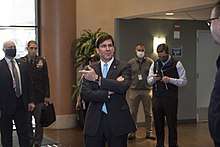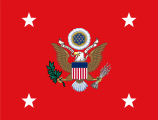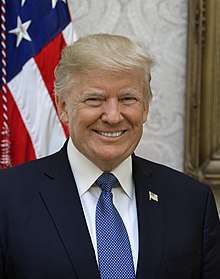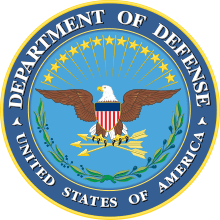Mark Esper
Mark Thomas Esper (born April 26, 1964)[1][2] is the 27th and current United States secretary of defense, and a former U.S. Army officer and defense contractor lobbyist. He previously served as the 23rd United States secretary of the Army from 2017 to 2019.
Mark Esper | |
|---|---|
 | |
| 27th United States Secretary of Defense | |
| Assumed office July 23, 2019 | |
| President | Donald Trump |
| Deputy | Richard V. Spencer (acting) David Norquist |
| Preceded by | Jim Mattis |
| In office Acting: June 24, 2019 – July 15, 2019 | |
| President | Donald Trump |
| Deputy | David Norquist (acting) |
| Preceded by | Patrick M. Shanahan (acting) |
| Succeeded by | Richard V. Spencer (acting) |
| 23rd United States Secretary of the Army | |
| In office November 20, 2017 – July 23, 2019* | |
| President | Donald Trump |
| Deputy | Ryan McCarthy |
| Preceded by | Ryan McCarthy (acting) |
| Succeeded by | Ryan McCarthy |
| Personal details | |
| Born | Mark Thomas Esper April 26, 1964 Uniontown, Pennsylvania, U.S. |
| Political party | Republican |
| Spouse(s) | Leah Lacy ( m. 1989) |
| Children | 3 |
| Education | United States Military Academy (BS) Harvard University (MPA) George Washington University (PhD) |
| Civilian awards | |
| Military service | |
| Allegiance | |
| Branch/service | |
| Years of service | 1986–2007 |
| Rank | |
| Unit | 101st Airborne Division Virginia Army National Guard D.C. Army National Guard U.S. Army Reserve |
| Battles/wars | Gulf War |
| Military awards | |
| *McCarthy served in an acting capacity from June 24, 2019 to July 15, 2019, while Esper served as acting secretary of defense. | |
President Donald Trump announced on June 18, 2019, that Esper would become acting secretary of defense, succeeding acting secretary Patrick M. Shanahan.[3] Before Shanahan withdrew his name from consideration for the position, Esper had been considered a leading candidate for the nomination had the Senate declined to confirm Shanahan.[4] Esper assumed the office of acting secretary on June 24, and was confirmed as 27th secretary of defense by the United States Senate with a vote of 90–8 on July 23, 2019.[5]
A West Point graduate, Esper formerly served as a U.S. Army officer. After leaving military service, he was a Senate staffer, chief of staff at the Heritage Foundation, and Vice President for Government Relations at Raytheon.
Early life and education
Esper was born in Uniontown, Pennsylvania, the son of Pauline "Polly" (Reagan) and Thomas Joseph Esper.[6] His father was a member of the Maronite Church.[7] His paternal grandfather was an immigrant from Lebanon, and his uncle was war journalist George Esper.[8]
Esper graduated from Laurel Highlands High School outside Uniontown, Pennsylvania, in 1982.[9] He received his Bachelor of Science in engineering from the United States Military Academy in 1986. Esper was a dean's list student at West Point and received the Douglas MacArthur Award for Leadership.[10] He received a master's degree in public administration from the John F. Kennedy School of Government at Harvard in 1995 and a doctorate in public policy from George Washington University in 2008.[11]
Career
Esper served as an infantry officer with the 101st Airborne Division and deployed with the "Screaming Eagles" for the Gulf War. His battalion was part of the famous "left hook" that led to the defeat of the Iraqi Army.[12] For his actions, Esper was awarded a Bronze Star, the Combat Infantryman's Badge, and various service medals.[10] He later commanded an airborne rifle company in Europe and served as an Army fellow at the Pentagon.[9] Esper served on active duty for more than ten years before moving to the Army National Guard and later the Army Reserve, rising to the rank of lieutenant colonel.[13] Esper is a recipient of the Department of Defense Medal for Distinguished Public Service. Among his military awards and decorations are the Legion of Merit, Bronze Star Medal, Kuwait Liberation Medal, and the Combat Infantryman Badge.[14]
Esper was chief of staff at the Heritage Foundation, a conservative think tank, from 1996 to 1998.[15] From 1998 to 2002, Esper served as a senior professional staffer for the Senate Foreign Relations Committee and the Senate Governmental Affairs Committee. He was also a senior policy advisor and legislative director for U.S. senator Chuck Hagel.[16] He was policy director for the House Armed Services Committee from 2001 to 2002. From 2002 to 2004, Esper served in the George W. Bush administration as deputy assistant secretary of defense for negotiations policy, where he was responsible for a broad range of nonproliferation, arms control, and international security issues. He was director for national security affairs for the U.S. Senate under Senate majority leader Bill Frist from 2004 to 2006.
Esper was executive vice president at the Aerospace Industries Association in 2006 and 2007. From September 2007 to February 2008, Esper served as national policy director to Senator Fred Thompson in his 2008 presidential campaign. From 2008 to 2010, Esper served as executive vice president of the Global Intellectual Property Center and vice president for Europe and Eurasia at the U.S. Chamber of Commerce. He was hired as vice president of government relations at defense contractor Raytheon in July 2010.[16] Esper was recognized as a top corporate lobbyist by The Hill in 2015 and 2016.[17][18] Esper's departure from Raytheon included a deferred compensation package after 2022, based partly on Raytheon's stock price.[19]
Secretary of the Army
President Donald Trump announced his intention to nominate Esper as Secretary of the Army on June 19, 2017.[20] He was Trump's third nominee for the position, following the withdrawals of Vincent Viola and Mark E. Green.[21] He was confirmed to this post by an 89–6 vote of the U.S. Senate on November 15, 2017[22] and sworn in on November 20, 2017.
While serving as Army Secretary, Esper was asked by reporters in 2018 whether soldiers had concerns about serving beside openly transgender individuals. He replied that "It really hasn't come up."[23] After he was nominated to become Secretary of Defense, he said that being transgender is not an issue with him, stating that he has met several transgender servicemembers and was impressed with many of them. He supports Directive-type Memorandum-19-004, claiming it is not a "blanket ban" on transgender military service and said that he believes anyone who can meet the military standards without "special accommodations" and is worldwide deployable should be able to serve, including transgender individuals as long as they can adhere to cisgendered standards associated with their biological sex. He said people in the military with gender dysphoria would have their condition assessed and "in many cases", be offered waivers that would allow them to serve. He cited the United States Department of Defense's 2018 Report and Recommendations on Military Service by Transgender Persons, which claims that persons who have a history of gender dysphoria, who have undergone medical treatments for gender transition, or who are unable or unwilling to meet the military's standards associated with their biological sex, could hurt military readiness and effectiveness and should be evaluated to see whether they should be retained or expelled from service.[24][25]
Secretary of Defense
Temporary appointment and nomination
.jpg)
Trump announced the appointment of Esper as Acting Secretary of Defense on June 18, 2019, after Acting Secretary Patrick Shanahan decided to withdraw his nomination.[3] Four days later, it was announced that Trump would nominate Esper to serve as Secretary of Defense in a permanent capacity.[26] On July 15, 2019, the White House formally sent his nomination to the Senate.[27][28] Following his formal nomination, Esper was replaced as Acting Defense Secretary by Secretary of the Navy Richard Spencer, as the Federal Vacancies Reform Act of 1998 prevented Esper from serving as acting secretary while his nomination was formally under consideration. During that period, Esper reverted to his position as Secretary of the Army.[29] The Senate Committee on Armed Services scheduled a hearing on the nomination for the next day.[30] On July 22, 2019, the Senate voted 85–6 to invoke cloture on his nomination.[31] On July 23, 2019, his nomination was confirmed by a vote of 90–8.[32]
Tenure


Esper has said that his operating positions as Secretary of Defense would be apolitical, in keeping with the National Defense Strategy formulated in 2018 by his predecessor Jim Mattis.[33]
On November 24, 2019, during a dispute regarding whether Navy SEAL Eddie Gallagher would be stripped of his Trident pin, Esper fired the United States secretary of the Navy, Richard Spencer. The Department of Defense attributed the firing to Spencer privately proposing to the White House (without informing Esper, and contrary to Spencer's public position) an arrangement to let Gallagher retire while keeping his Trident pin. On November 25, Esper stated that Trump had ordered him to stop the Navy from conducting a peer review regarding Gallagher's right to wear the pin. Esper said he previously supported the peer review, but followed Trump's order.[34] Meanwhile, Trump cited the Gallagher case as the primary reason for Esper's firing of Spencer, while also citing "large cost overruns" in the Navy.[35]
Esper met with his European counterparts in February 2020 to discuss basing options for a new United States Army headquarters in Europe, bearing the name "V Corps" that had originally been established in World War I but was inactivated while stationed in Germany in 2013. Esper stated the new headquarters was needed to improve military coordination among NATO partners.[36]
In response to the National Defense Authorization Act for Fiscal Year 2020, which included $738 billion in defense spending, Esper said: "I’m good with those dollars. No complaints."[37]
Withdrawal of U.S. forces from Afghanistan
On February 29, 2020, the Trump administration signed a conditional peace agreement with the Taliban, which calls for the withdrawal of foreign troops in 14 months if the Taliban uphold the terms of the agreement.[38][39] In May 2020, Esper said: "I don’t put a timeline on it. We have a timeline of May of next year but that timeline was premised on everything moving at a set pace."[40]
Withdrawal of U.S. forces from Germany
.jpg)
On June 6, 2020, Trump directed the Pentagon to remove 9,500 American troops from Germany – capping the total number at 25,000.[42] A White House official and Trump said the move was partially influenced by U.S. frustration with Nord Stream 2 gas pipeline from Russia to Germany, owned by Russia's Gazprom,[43][44] and with Germany's unwillingness to spend more on defense in support of NATO.[45][46] On June 24, 2020, Trump said at a press conference with Polish President Andrzej Duda that the United States plans to move some U.S. troops from Germany to Poland.[44] Trump said "I think [putting more US troops in Poland] sends a very strong signal to Russia."[47]
The announcement reportedly caught NATO, Germany, and the Pentagon off guard.[48] Trump's announcement faced immediate criticism from all corners, including from Republicans on Capitol Hill who believed the move would embolden Russia and harm NATO.[49] Trump's plan to withdraw troops created tensions with Esper and other top Defense Department officials, who feared that a withdrawal of U.S. troops from bases in Germany would compromised America's defense against Russia.[50]

On June 26, Esper traveled to NATO headquarters in Brussels to meet with NATO secretary general Jens Stoltenberg.[51]
On June 30, Esper met with Trump at the White House to brief him on the proposed Defense Department plan.[52] Trump approved Esper's proposal, recognizing that a rapid withdrawal of troops from Germany was “logistically impossible”.[53]
COVID-19 pandemic
In late January 2020, as the coronavirus spread, Esper said he was "not tracking" its spread, as the Trump administration downplayed the risks of the disease.[54][55]
As the coronavirus outbreak turned into a pandemic in early March 2020, Esper directed overseas commanders of U.S. forces to check with him before taking actions to protect U.S. troops, lest they contradict the Trump administration's messaging on the coronavirus. A Defense Department official said Esper's intent was to ensure that the government was "communicating to the public with one voice on a rapidly developing situation" and Esper assured the public that "My No. 1 priority remains to protect our forces and their families.”[56] The following week, Esper directed the deployment of two Navy hospital ships, the USNS Comfort and the USNS Mercy, to take pressure off New York and Los Angeles hospitals as they coped with the pandemic.[57] Esper also authorized the Defense Department to provide civilian health authorities with five million respirator masks and 2,000 specialized ventilators.[58]
In early April, Acting Secretary of the Navy Thomas Modly removed Navy Captain Brett Crozier from command of the aircraft carrier USS Theodore Roosevelt after Crozier pleaded with Navy leaders to move more quickly to in the face of a coronavirus outbreak on the ship. Esper defended Modly's decision,[59] though he conceded that he had not read Crozier's letter calling for help.[55] Within days, widespread condemnation led Modly to resign. Esper named James McPherson, Under Secretary of the Army, to replace him.[60]

On April 14, 2020, Esper announced the extension of a travel freeze on military members and Department of Defense civilian employees. The original order to stop movement was to last for 60 days, but Esper said that additional time was needed to stop the spread of the virus.[61] Several days following the announcement, Esper extended the freeze through June 30, 2020.[62]
Lawmakers, retired officers and experts criticized Esper's response to the coronavirus, describing it as slow and indecisive. According to Politico, there was discontent within the Department of Defense about Esper's leadership on the issue. Esper primarily left it up to local commanders in terms of how they would respond to the pandemic, which resulted in uneven responses. Several military officials said there was a lack of top-down planning and guidance on important decisions.[55] In a letter in late April 2020, ten Democratic senators called Esper's leadership "disjointed and slow", saying that DOD's civilian leadership had "failed to act sufficiently, quickly, and has often prioritized [combat] readiness at the expense of the health of service members and their families."[63] A Pentagon spokesman defended DoD's handling of the pandemic.[64][65]
In May 2020, at an event marking the 75th anniversary of the Allied victory in Europe, Esper interacted without a face mask with seven World War II veterans who were between the ages of 96 and 100. The elderly are at an elevated risk of illness and death from the coronavirus; health experts and authorities advise that the spread can be halted with face masks and social distancing measures. In response to critics, Jonathan Hoffman, a Pentagon spokesman, said Esper was tested before the event; a White House official said the veterans were also tested before the event.[66]
That same month, Esper declared that a widely available vaccine would be available by the end of 2020. However, a leaked Pentagon memo said there was a "real possibility" that a vaccine would not be available until "at least the summer of 2021."[67][68]
George Floyd protests
| Wikisource has original text related to this article: |
According to multiple reports, on June 1, 2020, amid nationwide civil unrest arising from the killing of George Floyd by police, Trump at one point demanded the deployment of 10,000 active-duty troops to the streets of Washington and other U.S. cities in a heated meeting in the Oval Office with Esper and Milley, who opposed this request.[69][70][71] Trump's spokesperson Alyssa Farah and Attorney General William Barr denied that Trump had requested the deployment of 10,000 active-duty troops, with Barr saying instead that Trump wanted troops on "standby."[69]
Esper participated in a June 1 call with state governors, Trump, and Barr, in which Trump urged governors to "dominate" and use aggressive methods.[72] During the call, Esper said, "I think the sooner that you mass and dominate the battlespace, the quicker this dissipates and we can get back to the right normal."[72] Esper's suggestion that American cities were a "battlespace" prompted significant criticism,[73][74] including from former Joint Chiefs of Staff chairman Martin E. Dempsey and former Special Operations Command head Raymond A. Thomas.[74] At a subsequent press conference, Esper said that he did not intend the use of the term to focus "on people, and certainly not on our fellow Americans."[75]
On June 1, Esper walked alongside Trump to a photo op in front of St. John's Episcopal Church outside the White House; just prior, police in riot gear and mounted police cleared protestors who had been throwing bricks and other projectiles[76] from Lafayette Square, using smoke and flash grenades and a chemical irritant spray, clearing a path for Trump, Esper and several other Trump administration officials.[77] Esper's participation in the photo op was criticized by a number of retired senior military officers.[78]
Two days later, at a Pentagon press conference, Esper said, regarding the Lafayette Park photo op, that, "Well, I did know that we were going to the church. I was not aware of a photo op was happening," adding, "And look, I do everything I can to try to stay apolitical and try and stay out of situations that may appear political. And sometimes I’m successful at doing that, and sometimes I’m not as successful, but my aim is to keep the department out of politics to stay apolitical."[79]
Esper broke with Trump by publicly opposing invocation of the Insurrection Act of 1807 and the deployment of active-duty troops in American cities, saying that "the National Guard is best suited for performing domestic support to civil authorities ... I say this not only as Secretary of Defense, but also as a former soldier, and a former member of the National Guard. The option to use active duty forces in a law enforcement role should only be used as a matter of last resort, and only in the most urgent and dire of situations. We are not in one of those situations now. I do not support invoking the Insurrection Act."[80] Esper's statement dampened Trump's push to invoke the Insurrection Act and changed the dynamic of the first two days. Esper took steps in the following days to further de-escalate the situation, removing weapons and ammunition from the National Guard, and returning troops to their home bases without notifying the White House. Trump, already furious about Esper's unwillingness to employ active duty troops, came close to firing him.[81]
On June 6, the House Armed Services Committee (HASC) invited Esper and Chairman of the Joint Chiefs of Staff Milley to testify before the committee regarding the events of June 1; they declined. Chief spokesman Jonathan Hoffman said in statement that the pair "have not 'refused' to testify'" and that the department's “legislative affairs team remains in discussion" with the committee.[82] HASC chairman Representative Adam Smith later acknowledged in a written letter that Esper and Milley may have been prevented from appearing by the White House.[83] Esper and Milley subsequently agreed to appear before the House Armed Services Committee on July 9.[84] In the meantime, on June 8, Army Secretary Ryan McCarthy to brief the committee on the presence of the National Guard in Washington, D.C., during the protests on June 1.[85]
Days later, Esper and Milley responded in detail to a series of questions asked of them by HASC chairman Smith regarding events during the week of June 1. Smith later said the Pentagon had been "reasonably cooperative" in providing witnesses to the committee amid logistical issues during the coronavirus pandemic.[84]
Addressing racial discrimination in the U.S. military
Amid the racial unrest across America in June 2020, Esper directed Pentagon civilian and uniformed leaders to come up with ideas that could be used to quickly improve equal opportunity, diversity, and inclusion in the Armed Forces; established an internal Defense Board on Diversity and Inclusion in the Military to recommend ways to increase racial diversity and ensure equal opportunity across all ranks, especially in the officer corps, by December 2020; and created a Defense Advisory Committee on Diversity and Inclusion in the Armed Services, mirroring the Defense Advisory Committee on Women in the Services.[86][87][88]
In a June 18, 2020, he said that while the Defense Department has often led on issues of race and discrimination, he cited underrepresentation of minorities in the officer ranks as a particular problem.[89][90]
Personal life
Esper married his wife, Leah Lacy, in 1989.[2][91] They have three children: Luke, John and Kate.[14][92]
References
- Zajac, Frances Borsodi (August 17, 2017). "Trump nominating Uniontown native for Army secretary | Local News". The Herald-Standard. Retrieved December 18, 2017 – via heraldstandard.com.
- "Secretary of the Army: Who Is Mark Esper?". AllGov.
- @realDonaldTrump (June 18, 2019). "....I thank Pat for his outstanding service and will be naming Secretary of the Army, Mark Esper, to be the new Acting Secretary of Defense. I know Mark, and have no doubt he will do a fantastic job!" (Tweet) – via Twitter.
- "Shanahan withdraws from consideration to be U.S. defense secretary". Reuters. June 18, 2019. Retrieved June 18, 2019.
- Youssef, Nancy A. (July 23, 2019). "Mark Esper Sworn In as Defense Secretary". Wall Street Journal. Retrieved July 25, 2019.
- Zajac, Frances Borsodi (March 8, 2018). "Uniontown native serves country as Secretary of the Army". The Herald-Standard.
- "Thomas Joseph Esper". The Herald-Standard. December 5, 2014.
- "Pentagon and Hanoi defense chiefs trade artifacts of soldiers missing from Vietnam War". Washington Examiner. November 22, 2019.
- Basinger, Rachel (August 31, 2013). "Laurel Highlands to honor Hall of Fame inductees". TribLIVE.
- Ekas, Cindy (September 7, 2017). "Laurel Highlands lauds alumni's achievements". Pittsburgh Tribune-Review. Trib Total Media. Retrieved September 25, 2017 – via Trib LIVE (triblive.com).
- Hubler, David (July 16, 2010). "Raytheon adds defense expert to lead government relations unit". Washington Technology.
- Eric Milzarski (Nov. 17, 2017) This is what you need to know about Mark Esper, the new Army Secretary: Served in 3-187th Infantry battalion.
- Shane III, Leo (July 19, 2017). "Trump to nominate Raytheon VP, Gulf War vet as next Army secretary". Military Times.
- Defense.gov (July 23, 2019) Dr. Mark T. Esper: Secretary of Defense Department of Defense biography
- "U.S. Chamber Bolsters Its Europe-Eurasia Team". U.S. Chamber of Commerce. November 20, 2008.
- "Raytheon Names Mark T. Esper Vice President of Government Relations". Raytheon: Investors: Investor Relations. Raytheon. July 16, 2010. Retrieved September 25, 2017 – via investor.raytheon.com.
- Dickson, Rebecca (October 29, 2015). "Top Lobbyists 2015: Corporate". The Hill.
- Dickson, Rebecca (October 26, 2016). "Top Lobbyists 2016: Corporate". The Hill.
- Bort, Ryan (July 17, 2019). "Trump's Pick for Defense Secretary Is as Swampy as You'd Expect". Rolling Stone. Retrieved January 18, 2020.
- McIntyre, Jamie (July 19, 2017). "Exclusive: Trump to nominate Mark Esper as Army secretary". Washington Examiner.
- Gibbons-Neff, Thomas; Jaffe, Greg (July 19, 2017). "Trump to nominate Raytheon lobbyist for next Army secretary". Washington Post.
- "PN811 – Mark T. Esper – Department of Defense". U.S. Congress. November 15, 2017. Retrieved November 16, 2017.
- Mclaughlin, Elizabeth. "Soldiers not asking about transgender policy: Army secretary". ABC News.
- "CNN'S Amanpour Transcripts". edition.cnn.com. June 6, 2019. Retrieved August 23, 2019.
- "Senate Armed Services Committee Advance Policy Questions for Dr. Mark T.Esper Nominee for Appointment to be Secretary of Defense" (PDF).
- Cooper, Helene (June 21, 2019). "Trump Nominates Mark Esper as Next Defense Secretary". The New York Times. Retrieved June 22, 2019.
- "One Nomination Sent to the Senate". The White House.
- "PN934 — Mark T. Esper — Department of Defense". U.S. Congress. July 15, 2019. Retrieved July 16, 2019.
- Jim Garamone (July 15, 2019). "Esper nominated as Defense Secretary, Spencer now Acting Secretary". United States Department of Defense. Retrieved July 24, 2019.
- "Nomination -- Esper". U.S. Senate Committee on Armed Services. Retrieved July 16, 2019.
- "U.S. Senate: U.S. Senate Roll Call Votes 116th Congress - 1st Session". senate.gov.
- "U.S. Senate: U.S. Senate Roll Call Votes 116th Congress - 1st Session". senate.gov.
- Ryan, Missy; Lamothe, Dan (August 6, 2019). "Defense secretary Mark Esper wants to deliver on the goal of outpacing China". The Washington Post. Retrieved August 23, 2019.
- Burns, Robert. "Esper says Trump ordered him to stop SEAL review board". Associated Press. Retrieved November 26, 2019.
- McLaughlin, Elizabeth; Martinez, Luis. "Pentagon chief Mark Esper fires Navy Secretary Richard Spencer over handling of Navy SEAL case". ABC News. Retrieved November 25, 2019.
- Youssef, Nancy A. (February 12, 2020). "Army Sets Up Base to Coordinate With Europe" (Page A6). The Wall Street Journal. Retrieved February 15, 2020.
- "The debt and spending deal includes $738 billion for defense, and the Pentagon has 'no complaints'". CNBC. July 30, 2019.
- "Esper: US troops can withdraw 'with or without' Afghan peace deal". Al Jazeera. December 17, 2020.
- "Defense Secretary Gives Go-Ahead For U.S. Troops To Start Afghan Drawdown". NPR. March 2, 2020.
- "Esper not confident in Afghanistan troop withdrawal before election". Military Times. May 27, 2020.
- "Trump, Poland's Duda discuss sending some U.S. troops to Poland from Germany". Reuters. June 24, 2020.
- "Trump directs Pentagon to pull 9,500 US troops from Germany by September". The Wall Street Journal. June 6, 2020. Retrieved July 6, 2020.
- "Poland's Duda promises 'stronger alliance' with Donald Trump during U.S. visit". Euronews. June 25, 2020.
- "Trump: Poland to get some US troops withdrawn from Germany". Star Tribune. June 24, 2020.
- Bowden, Ebony (June 24, 2020). "Trump announces plan to slash troops in Germany over NATO funding". New York Post. Retrieved July 6, 2020.
- Gearan, Anne (June 24, 2020), "Trump confirms plan to slash U.S. troop presence in Germany; some 'probably' will relocate to Poland", Washington Post, retrieved July 6, 2020
- "Trump's plan to 'probably' move troops to Poland reveals a dangerous lack of a real strategy". Business Insider. July 3, 2020.
- "Trump orders large withdrawal of U.S. forces from Germany". www.msn.com. Retrieved July 6, 2020.
- Vazquez, Maegan and Veronica Stracqualursi. "Trump indicates he's not budging on reducing number of US troops in Germany". CNN. Retrieved July 6, 2020.
- Cohen, Zachary, Vivian Salama and Barbara Starr. "Germany troop withdrawal highlights Esper's isolation". CNN. Retrieved July 6, 2020.
- Cook, Lorne (June 28, 2020). "Esper seeks to reassure NATO over US troop plans". Military Times. The Associated Press. Retrieved July 6, 2020.
- "Pentagon says Trump has approved plans to cut troops in Germany". www.msn.com. Retrieved July 6, 2020.
- Cohen, Zachary, Vivian Salama and Barbara Starr. "Germany troop withdrawal highlights Esper's isolation". CNN. Retrieved July 6, 2020.
- "Inside The Pentagon's Lurching Efforts To Protect Its People from the Coronavirus". Defense One. Retrieved June 2, 2020.
- "'Lack of leadership': Esper's pandemic response draws fire as crisis deepens". POLITICO. Retrieved June 2, 2020.
- Schmitt, Eric; Cooper, Helene (March 2, 2020). "Defense Secretary Warns Commanders Not to Surprise Trump on Coronavirus". The New York Times. ISSN 0362-4331. Retrieved March 15, 2020.
- Burgess, Richard R. (March 18, 2020). "Esper Orders Navy to Ready Hospital Ships to Take Pressure Off U.S. Hospitals". Seapower. Retrieved March 19, 2020.
- Burns, Robert (March 17, 2020). "Esper: Pentagon to give respirator masks, ventilators to HHS". Associated Press. Retrieved March 19, 2020.
- Cole, Devan. "Esper defends removing USS Theodore Roosevelt commander who sounded alarm over coronavirus". CNN. Retrieved April 15, 2020.
- Martinez, Luis. "Acting Navy secretary resigns after carrier remarks, Esper names replacement". ABC News. Retrieved April 15, 2020.
- Mitchell, Ellen. "Pentagon to extend troop movement freeze past May 11". The Hill. Retrieved April 15, 2020.
- Crawford, Jamie. "Esper to extend travel restrictions for Defense Department personnel". CNN. Retrieved April 29, 2020.
- "Senate Democrats rip Pentagon's coronavirus response in letter to Esper". Stars and Stripes. Retrieved June 2, 2020.
- Kheel, Rebecca. "Senate Democrats pan Esper for 'failed' coronavirus response". The Hill. Retrieved April 29, 2020.
- Williams, Katie Bo. "Pentagon's Esper Was Too Slow With Coronavirus Response, Senate Democrats Say". Defense One. Retrieved April 29, 2020.
- "Defense Secretary Esper stood beside World War II veterans — without a mask". The Washington Post. 2020.
- Britzky, Haley. "Leaked Pentagon memo warns of 'real possibility' of COVID-19 resurgence, vaccine not coming until summer 2021". Task & Purpose. Retrieved June 2, 2020.
- Myers, Meghann (May 19, 2020). "Pentagon memo contradicts Esper's year-end coronavirus vaccine goal, per report". Military Times. Retrieved June 2, 2020.
- Martin, David (June 7, 2020). "Trump demanded 10,000 active-duty troops deploy to streets in heated Oval Office meeting". CBS News.
- Phil Stewart (June 7, 2020). "Trump wanted to deploy 10,000 troops in Washington D.C., official says". Reuters.
- Barbara Starr, Sarah Westwood, Lauren Fox and Sunlen Serfaty (June 7, 2020). "White House wanted 10k active duty troops to quell protesters". CNN.CS1 maint: multiple names: authors list (link)
- "READ: President Trump's call with US governors over protests". CNN. Retrieved June 26, 2020.
- Jack Detsche, The Pentagon Distances Itself From Trump, Foreign Policy (June 3, 2020).
- Thomas Gibbons-Neff, Helene Cooper, Eric Schmitt and Jennifer Steinhauer, Former Commanders Fault Trump’s Use of Troops Against Protesters, New York Times (June 2, 2020).
- "Secretary of Defense Mark Esper Press Conference Transcript: Does Not Support Military Response to Protests". REV. Retrieved July 6, 2020.
- Gelles, Karl. "How police pushed aside protesters ahead of Trump's controversial church photo". Retrieved June 10, 2020.
- Baker, Peter; Haberman, Maggie; Rogers, Katie; Kanno-Youngs, Zolan; Benner, Katie; Willis, Haley; Triebert, Christiaan; Botti, David (June 2, 2020). "How Trump's Idea for a Photo Op Led to Havoc in a Park". The New York Times. ISSN 0362-4331. Retrieved June 4, 2020.
- Stephen Collinson, Military leaders condemn Trump over protest response, CNN (June 4, 2020).
- "Secretary of Defense Mark Esper Press Conference Transcript: Does Not Support Military Response to Protests". Rev. Retrieved June 26, 2020.
- Schmitt, Eric; Cooper, Helene; Gibbons-Neff, Thomas; Haberman, Maggie (June 3, 2020). "Esper Breaks With Trump on Using Troops Against Protesters". The New York Times. ISSN 0362-4331. Retrieved June 26, 2020.
- Sonne, Paul; Nirappil, Fenit; Dawsey, Josh (June 5, 2020). "Pentagon disarms National Guard activated in D.C., sends active-duty forces home". Washington Post. Retrieved June 26, 2020.
- Mehta, Aaron (June 8, 2020). "House Armed Services Committee, Pentagon clash over Esper and Milley testimony". Defense News. Retrieved June 26, 2020.
- "Defense committee chairman expresses 'profound frustration' with Esper". news.yahoo.com. Retrieved July 6, 2020.
- Kheel, Rebecca (June 30, 2020). "Pentagon leaders set to testify before House panel July 9". TheHill. Retrieved July 6, 2020.
- Kheel, Rebecca (June 8, 2020). "Army briefs House panel on response to DC protests". TheHill. Retrieved June 26, 2020.
- Cooper, Helene (June 25, 2020). "Addressing Diversity, Army Will Remove Photos of Officer Candidates in Promotion Reviews". The New York Times. ISSN 0362-4331. Retrieved July 1, 2020.
- "Mark Esper announces 3 initiatives to improve racial equity in military". UPI. Retrieved July 1, 2020.
- "Esper to create DOD boards to study military diversity, says Pentagon must lead on the issue". Stars and Stripes. Retrieved July 1, 2020.
- "Secretary Mark T. Esper Message to the Force on DOD Diversity and Inclusiveness". U.S. DEPARTMENT OF DEFENSE. Retrieved July 1, 2020.
- "Pentagon launches plan to increase diversity, end discrimination in military". The Washington Times. Retrieved July 1, 2020.
- "Mark Esper, Secretary of Defense". Presidential Prayer Team. April 23, 2020. Retrieved June 18, 2020.
- "Mark Esper". The Hill. Retrieved June 18, 2020.
External links
| Wikimedia Commons has media related to Mark Esper. |
- "Dr. Mark T. Esper > U.S. DEPARTMENT OF DEFENSE > Biography". U.S. Department of Defense. Retrieved November 5, 2019 – via defense.gov.
- Appearances on C-SPAN
| Political offices | ||
|---|---|---|
| Preceded by Ryan McCarthy Acting |
United States Secretary of the Army 2017–2019 |
Succeeded by Ryan McCarthy |
| Preceded by Patrick M. Shanahan Acting |
United States Secretary of Defense Acting 2019 |
Succeeded by Richard V. Spencer Acting |
| Preceded by Jim Mattis |
United States Secretary of Defense 2019–present |
Incumbent |
| U.S. order of precedence (ceremonial) | ||
| Preceded by Steve Mnuchin as Secretary of the Treasury |
Order of Precedence of the United States as Secretary of Defense |
Succeeded by William Barr as Attorney General |
| U.S. presidential line of succession | ||
| Preceded by Steve Mnuchin as Secretary of the Treasury |
6th in line as Secretary of Defense |
Succeeded by William Barr as Attorney General |





